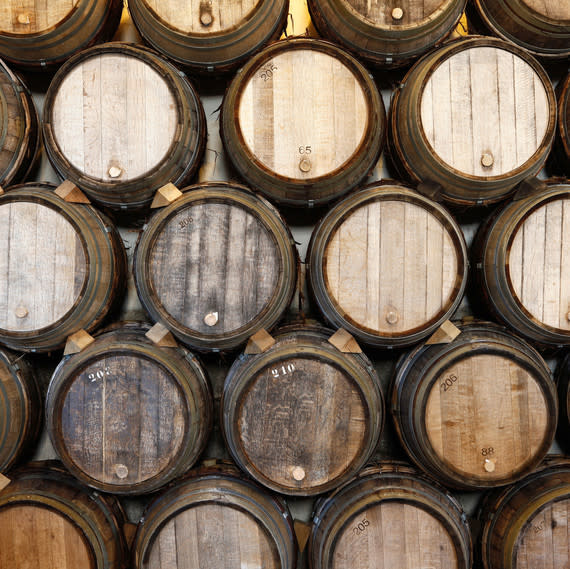Why Are Oak Barrels Used to Age Wine?

Have you ever wondered why oak barrels have been the number one vessel for aging wine for centuries, or what effects the oak has on the finished wine? We're taking a look here. The answers to these questions will help you decided if oak is something you want to look for when buying wine or not.
Related: How to Navigate a Restaurant's Wine List Like a Pro
Why Are Oak Barrels Used to Age Wine?
On the surface, winemaking is a simple process: take grape juice, allow yeast to ferment the natural sugars into alcohol, and you have wine—at least that's the basic process. There are many nuances to that process and in addition, most wines also undergo an aging process to allow oxygen to further evolve the molecules into a more complex and delicious tasting beverage. In ancient times, the vessels used to age wine were enormous clay jars called amphorae. These are heavy and so difficult to transport, as well as easily breakable. You can still find wines aged in amphorae in many parts of Eastern Europe. Once it was discovered that oak wood was not only in plentiful supply, but soft enough to be bent into a barrel shape that was lighter and more portable, oak barrels quickly became the default way to age and transport wine.
How Oak Affects the Taste of Wine
Besides being a more practical vessel for transporting wine (remember, bottling technology is a recent innovation so it was most common to ship wine still in the barrel, and bottle it when it reached its destination), oak barrels impact the flavor and texture of the finished wine. Because oak has a grain, it has natural nooks and crannies for the liquid to seep into and the wine pulls out natural extracts in the wood that contribute to the wine's flavor. If you taste vanilla, butter, coconut, dill, cinnamon, nutmeg, or a toastiness in your wine, these flavors and aromas are coming from the oak. Oak also has a textural influence: Since oak is porous, a bit of oxygen naturally passes in and out which can soften the sharp edges of a high-acid or high-tannin wine and make it taste smoother.
Not All Oak Is the Same
Here comes the fun part: A winemaker can use oak as a tool when they make wine. Many winemakers refer to their oak program as a "spice rack," and they can use different types of oak to impart a diverse range of flavor or age the wine in oak for different durations to extract more or less oak influence. The two most common types of oak used are French and American. French oak tends to be more subtle in its flavor influence because it has a tighter grain and may give delicate vanilla flavors, whereas American oak is generally more powerful and will give more coconut or rich buttery flavor.
Oak barrels are expensive, which is why many wineries re-use them. Brand-new oak barrels have the most impact in terms of how they flavor the wine, and then each time you fill an oak barrel there's less and less flavor to extract. Imagine using the same tea leaves multiple times in your pot of tea: The "first fill" is the strongest and most intense extraction, and every refill after that gives a weaker flavor influence. This is one more tool for winemakers to use. Many of them prefer used barrels if they're looking for a more delicate oak expression.
How Can You Tell If a Wine Has Been Aged in Oak?
Not all wine is aged in oak. Stainless steel barrels are widely used, and they do not give a flavor influence to the wine. Instead, they showcase the flavors in the fruit itself, and these wines are brighter and crisper in flavor. Wine can also be aged in cement, glass, or even plastic. It can be difficult to know the barrel treatment of a wine just by looking at it on the shelf because not all wineries put that information on the label. It's more common than it used to be (you will see many labels that advertise "Unoaked Chardonnay"), but usually the staff at a good wine shop will be able to tell you what kind of oak treatment is used in each bottle.
To Oak or Not to Oak?
One popular philosophy is that a great winemaker uses oak like a chef uses salt: The right amount can enhance the flavors—too much and it's all you can taste. Striking the right balance of oak is a constant challenge for winemakers. Also, just as with seasoning food, personal palate matters! Some wine lovers prefer a lot of oak flavor and some prefer less. The only way to discover what you like is to taste a lot of wine—a homework assignment that most of us will happily undertake!
(function(d, s, id) { if (d.getElementById(id)) return; var js = d.createElement(s); js.id = id; js.src = '//cdn4.wibbitz.com/static.js'; d.getElementsByTagName('body')[0].appendChild(js); }(document, 'script', 'wibbitz-static-embed'));
